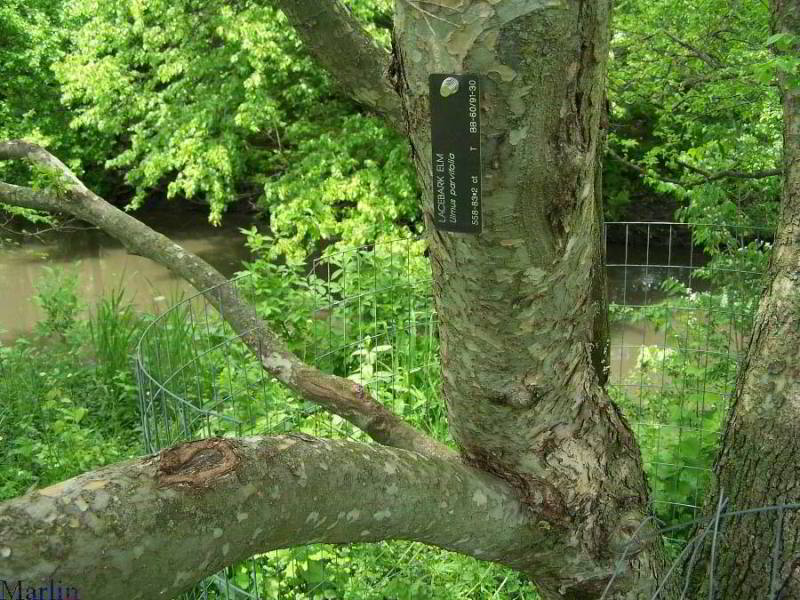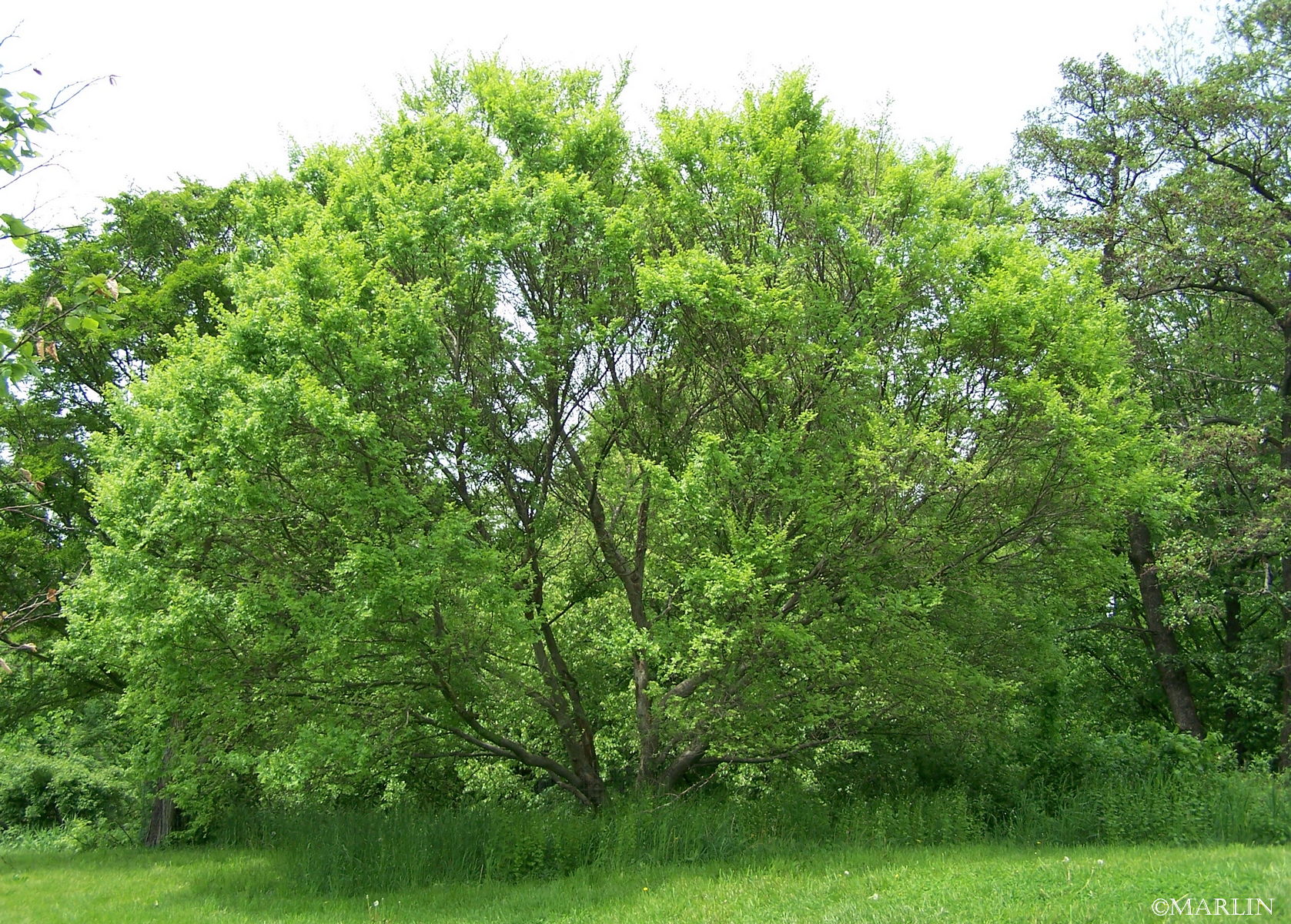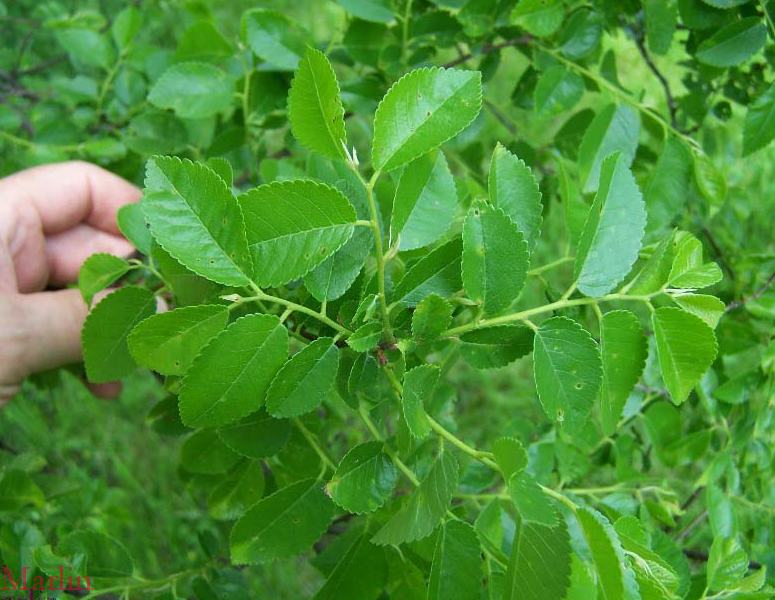Chinese Elm – Ulmus parvifolia
An excellent tree that is surprisingly under-used, Chinese Elm possesses many traits which make it ideal for a multitude of landscape uses. A fast growing, deciduous or evergreen tree, Chinese Elm forms a graceful, upright, rounded canopy of long, arching, and somewhat weeping branches which are clothed with two to three-inch-long, shiny, dark green, leathery leaves. Some specimens grow in the typical vase-shaped elm form. In colder regions of the country in fall, leaves are transformed into various shades of red, purple, or yellow.
The tree is evergreen in the southern extent of its range. The showy, exfoliating bark reveals random, mottled patterns of grey, green, orange, and brown, adding great textural and visual interest, especially to its winter silhouette. Chinese Elm can reach 80 feet in height but is more often seen at 40 to 50 feet, making it an ideal shade, specimen, street or parking lot tree. They look very nice planted in a grove or along a street.

Ecological Impacts: It is an ornamental tree in urban areas planted for tough durability, interesting bark and yellowish to reddish purple fall foliage as well as being resistant to Dutch elm disease and air pollution. It has escaped intended plantings to invade native plant communities. The aggressive root system absorbs water, nutrient, and space. It is reported invasive in DC, NC, NE, NJ, VA, and WI. [5]
The Morton Arboretum, at Lisle, Illinois, is home to the largest Elm collection in North America. Under study, the collection includes almost all of the 22 Elm species native to China, a dozen of which show resistance to Dutch elm disease and elm yellows. The Arboretum in past years has bred and marketed five new elm varieties resistant to Dutch elm disease. [1]
Chinese Elm will grow in full sun on a wide range of soils, adapting easily to extremes in pH (including alkaline) or moisture, and tolerates urban heat, and wind. Trees will look their best, though, when grown in moist, well-drained, fertile soil but they adapt to drought and the extremes of urban sites. Very suitable for street tree pits, parking lot islands, and other confined soil spaces.
Many cultivars are available for size and form: Catlin is dwarf; Drake, USDA hardiness zones 7 to 9, has small, dark green leaves, sweeping, upright branches forming a rounded crown, and greater leaf retention being almost evergreen in California and Florida; Dynasty has smooth, dark grey bark, smaller leaves and is vase-shaped, with red fall color in the north; Frosty has a small (0.75-inch-long), whitemargined leaf which may revert back to green; Emerald has a dark green, fine-textured uniform crown comprised of ascending branches with bright orange, grey and brown exfoliating bark. It is a brand new introduction and the parent tree is reportedly 50 years, 32 feet tall and 54 feet wide; Golden Rey is reportedly hardy to USDA hardiness zone 6, is a moderate grower and may be denser and more compact than the species. This cultivar was selected for its yellow new foliage color which deepens to golden yellow in autumn.
Pathfinder has been extensively tested in Ohio for 30 years (USDA hardiness zone 5a). It has a single trunk with broad, upright branches and grows at a moderate height. Bark is nicely exfoliating, fall color is a rich red and this National Arboretum/Ohio Research Site introduction tolerates wet and dry soil. A good tree for tough sites; Sempervirens (Pendens) is more round-headed, weeping and spreading with persistent foliage, almost evergreen in USDA hardiness zones 8b through 10; and True Green has glossy, deep green leaves, a graceful, round-headed outline, and tends to be evergreen. Propagation is by seed, summer cuttings, or grafts.
This elm’s pests are borers and chewing insects. It shows considerable resistance to elm leaf beetle and Japanese beetle. Diseases It is usually resistant to Dutch Elm Disease and phloem necrosis. Cankers may develop on young trunks where soil is excessively wet. These occur on nursery and landscape trees. The causal agent has not been identified but theories abound. Twig blight can be an occasional problem. [4]
References
- The Morton Arboretum, Arboretum Records Honor, Milestone; Looks to Future
- The University of Texas at Austin, BIO 406D Native Plants of Central Texas
- The Morton Arboretum, Dutch Elm Disease, http://www.mortonarb.org/res/CLINIC_dis_dutchElm.pdf
- Edward F. Gilman and Dennis G. Watson, USDA Forest Service, Chinese Elm – Ulmus parvifolia
- USDA Forest Service, Forest Health Staff, Invasive Plants website WOW 04-18-05
Insects & Spiders Home | Elm Index | Tree Encyclopedia | Trees Index



